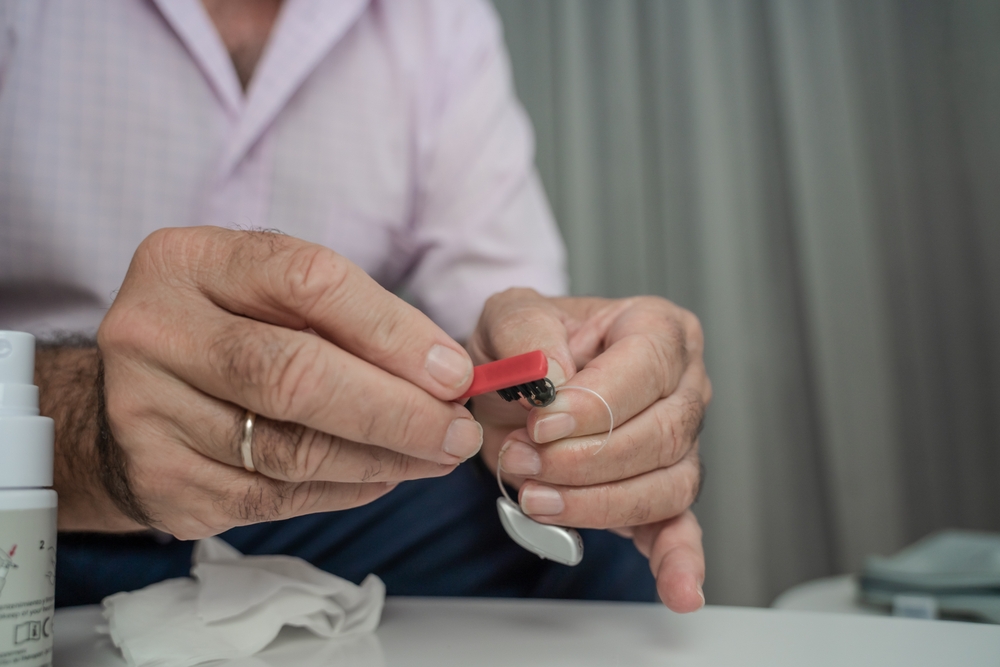
After you have become familiar with using your hearing aid, it becomes an essential element of your daily schedule. The thought of it malfunctioning can be daunting, not just because of the inconvenience but also thanks to the prospective expense of repairs or replacements.
Tips for maintaining and maximizing your hearing aid performance
By recognizing the potential hazards that can harm your hearing aid and taking measures to care for it properly, you can preserve its performance and continue to enjoy the improved quality of life it provides.
Proper battery care
Your hearing aid’s performance is heavily dependent on its battery. Therefore, picking the correct batteries for your hearing aid is essential. Discuss with your audiologist to find out which battery type is most suitable for your specific hearing aid model.
Handling the batteries with care is equally important. Oils, dirt, and moisture from your hands can contaminate the batteries, causing potential damage.
Always wash your hands before swapping out the battery, and be certain they are completely dried to avoid introducing moisture into the device.
Adhere closely to the manufacturer’s directions, especially regarding battery upkeep. To increase the battery life of your hearing aid, make sure to power it down when not using it and keep it stored in a secure, dry spot. Knowing the average lifespan of a battery can also be quite handy.
Make a note on your calendar each time you replace the battery, so you can estimate when it will require changing again. To avoid being stuck without power, always carry a spare battery with you, especially when you’re away from home.
Prevent moisture damage
As electronic technology, hearing aids are susceptible to moisture. Even minimal exposure can result in damage or a complete malfunction of the device. Protect your hearing aid’s performance by acquiring a specialized drying device to maintain its functionality by eliminating moisture. This device can safely store your hearing aid when it’s not in use, keeping it dry and free from moisture-related issues.
To protect your hearing aid from water damage, it’s a smart idea to take it out before participating in activities that make you sweat heavily. However, consult your hearing specialist first, as taking out your hearing aid during exercise, especially outdoors, may pose safety concerns by limiting your ability to hear environmental sounds like traffic or alarms. If possible, choose to work out inside where it is safer to take out your hearing aid, and make sure to remove your device before bathing or swimming.
Moreover, it is recommended to refrain from using spray deodorants, hairspray, and any other aerosol products when your hearing aid is in your ear. These products contain moisture and chemicals that can build up on the device, leading to long-term damage. In order to minimize exposure, use these types of products before putting in your hearing aids.
Avoid excessive ear wax accumulation
Although earwax serves as a natural barrier, shielding your ears from debris, dirt, and tiny insects, it can also hamper the effective functioning of your hearing aid. The buildup of earwax in the device can lead to it not functioning properly. To manage this, have your ears examined by your hearing specialist or physician to assess the level of earwax buildup and create an appropriate cleaning routine for both your ears and your hearing aid.
It is necessary to clean your ears carefully and never put anything foreign into your ear canal. Instead of that, let warm water go into your ears while you are showering. This can assist in losening up and removing some of the earwax. Routine professional ear cleaning is also recommended. While this may seem inconvenient, it’s much less troublesome than managing a malfunctioning hearing aid caused by excessive earwax.
To properly clean your hearing aid, carefully adhere to the guidelines provided by the manufacturer.
Different types of hearing aids may require different cleaning techniques, and using the wrong method could cause harm to your device. If you’re unsure about the proper cleaning method, consult your hearing specialist or hearing aid provider to ensure you’re taking the correct steps to protect your device from earwax damage.
Basic steps for lasting dependability
After you’ve become familiar with wearing your hearing aids, they become an essential part of your life, making it difficult to envision managing without having them. By implementing a few simple safety strategies, you can protect your hearing aids from harm and preserve their reliability over the long run. Prioritize routine maintenance, store them properly, and handle them with care, ensuring you can continue to reap the benefits of enhanced communication and a more fulfilling lifestyle.
Make an appointment if you’re experiencing issues with your hearing aid or need to set up a regular maintenance appointment.

